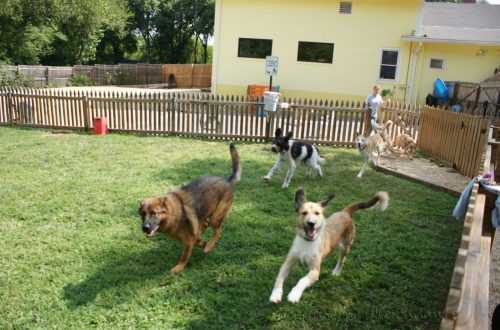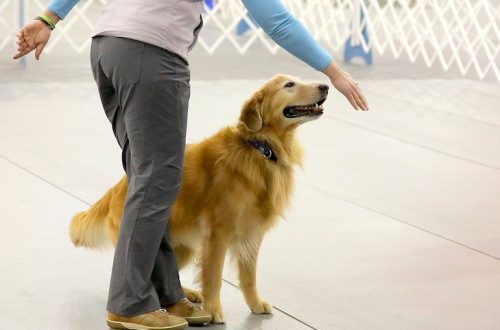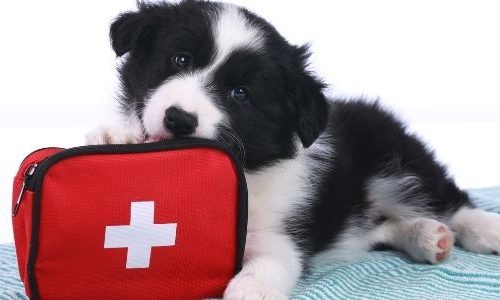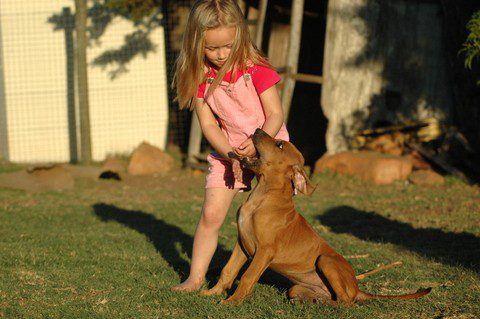
سپي ماشوم غوڅ کړ
The client is horrified: the dog bit her child in the face! Moreover, a dog that has been living in their family for several years and has never shown aggression towards people before. And here you go!
Who is to blame in this situation? Dog? Not! Child? Also no! The responsibility lies with the parents. But, alas, children or dogs most often pay for the mistakes of adults (the latter often pay with their lives).
The good news is that adults can provide safe communication for both children and dogs.
Fortunately, in this case, adults had the courage and intelligence to admit their mistakes and correct them in order to avoid similar troubles in the future. The dog remained in the family, and until now everyone lives happily.
Why did I write that the responsibility lies with the parents? How to keep a child safe? And what to do if a child is bitten by a dog, one’s own or someone else’s? Let’s figure it out.
کړی
Why do dogs bite children?
To understand how to protect your child from dog bites, you need to know why dogs bite children.
Duke University (USA) published statistics according to which dogs bite children more often than adults. Moreover, in the vast majority of cases, children are bitten by pets with whom the children are well acquainted – either living in the same family, or dogs of acquaintances. Most often, dogs bite children on the face, head, arms or legs.
The most typical portrait of a dog bite victim is as follows: a boy under the age of 10 who was left alone with a dog and who tried to take away the animal’s favorite toy or food, that is, encroached on a significant resource.
Moreover, in 75% of dogs that bit a person, this episode turned out to be the only one in life. That is, in principle, any stick can shoot at least once.
Actually, in the example I wrote about, everything was typical: a 5-year-old child tried to take away his favorite squeaker from the dog and, having driven it into a corner, did not give the opportunity to avoid conflict. The result is in the face…
However, blaming dogs is unfair and stupid. Because dogs always warn about their intentions, and in a very unambiguous way. And our task is to heed these warnings and teach the same to children.
How to understand that a dog can bite a child?
Many problems would never have arisen if we had been a little more attentive and responsible. Remember that the dog does not at all seek to conflict with a person, especially with a friend. Biting is a last resort for most dogs.to which they go out of desperation.
On the Internet, you can find a bunch of “touching” videos of a dog and a child communicating, which no one who even understands the behavior of dogs can watch without a shudder. Personally, my hair stands on end when I see this.
In the video, the dog is clearly showing signals of discomfort. And the best thing parents can do is to let her go and avoid contact with the child.There are 10 signals that a dog sends in the hope of avoiding conflict. They need to be able to decipher.
- The dog squints, yawns, licks. This is a clear sign of discomfort. Already at this stage it is necessary to leave the dog alone – and everyone will be happy.
- سپی turns his head away.
- سپی turns back to the child.
- The dog is trying to get away. Don’t interfere with her! And forbid children (categorically forbid!) to hold the dog by force and force it to communicate. The pet has the right to personal space. And to drive a dog into a corner means to provoke it into a conflict.
- سپی غوږونه یې فشاروي.
- The dog tucks its tail and cringes. This is a very clear sign that your company is unpleasant for the animal, and a polite request to leave it alone. Listen finally!
- سپی lays down on its side. Many confuse this pose with an expression of pleasure, when the animal exposes the stomach for scratching. However, in case of discomfort, the dog is tense and as soon as you remove your hand, it will immediately try to jump up.
- The dog looks into the eyes (and it is important not to confuse this intense look with a soft, full of love when the pet offers contact), while wrinkle nose and show teeth. This is already a direct threat, and it is extremely stupid to continue communication.
- dog growls. This is the red zone!
- If you or your child is extremely slow or insensitive, the dog has no choice but to put in teeth.
It is important to understand that all these signals are beacons that not everything is going smoothly in your relationship with the dog. Yes, a growl or a threatening grin is not a reason to rejoice and praise a pet, but punishing a dog for such signals is stupid.
Never punish your dog for growling! This is not a desire to “dominate”, but the dog’s last attempt to negotiate peacefully and avoid conflict.
Much smarter to understand why she is forced to act in such a way, find the root of the problem and work on it – Humane methods. Fortunately, modern cynology provides such an opportunity.
سربیره، punishing a dog for warning signals is simply dangerous – realizing that they do not listen to her and it is useless to negotiate with you and your child, she will simply move on to the last stage without prior notice.
This is what often happens to small dogs, who have learned the hard way that warnings don’t work on humans. And if at the menacing look of a lap dog or a chihuahua you will be touched: “Oh, he is trying to seem brave and big, go away!” and continue to squeeze the dog, do not be surprised that after a while, in response to an attempt to get closer to the pet, you will be attacked.
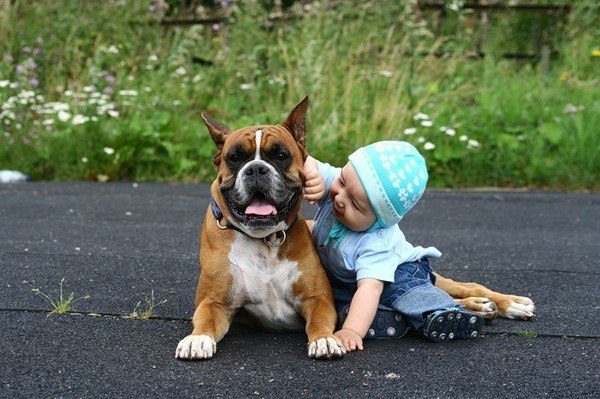



عکس: google.com In addition, small dogs already feel extremely vulnerable – after all, there are only Gullivers around, who do nothing to injure or even kill! And if the phlegmatic Newfoundland calmly endures the squeeze from the side of a five-year-old child, not seeing any threat in this, then the Russian Toy may react nervously.
So, although it may seem paradoxical, dealing with large dogs is much safer than with small ones.
Remember that the dog uses all available communication signals. Your responsibility is to learn to understand her language and show respect, as well as work on the problems that have arisen in humane ways. And be sure to teach your child to respect the dog and understand its warning signals. It’s simple, the main thing is a little care.
What to do so that a strange dog does not bite a child?
The answer is simple: teach your children to communicate with other people’s dogs correctly.
One day, a girl of three years old unexpectedly rushed to my Airedale. She tightly grabbed my dog by the neck and shoved a cookie into his mouth. Along with half a hand. I froze in surprise. Erdel, fortunately, too. He didn’t even close his mouth – he just stood there, his mouth open, from which a trickle of saliva flowed – cookies on his tongue! Both the girl and her father (who was standing nearby, smiling happily) were lucky that the dog reacted in this way. And what if a creature weighing almost 40 kg didn’t even bite out of surprise, but, for example, just jumped a little to the side and knocked the child down?
Of course, there are times when a dog rushes at strangers (or children) and bites without provocation on their part. But such cases are rare, as a rule, they are widely covered in the press and embellished by journalists in order to increase the rating of the media and cause a wave of indignation against dogs and their owners in society. However, this is a topic for a separate article. But in the vast majority of cases, the responsibility, again, lies with the parents – and therefore, in their power to prevent trouble.
There are simple rules that will most likely keep your child safe from conflict with a strange dog.
Don’t let your child approach other dogs. If you really want to, ask permission from the owner. You may be surprised, but not all dogs are required to love your children and burn with the desire to communicate with them. Unfortunately, in my many years of dog ownership, I have only heard such a request twice. In other cases, children (with the connivance of their parents) rush to the dogs, not at all caring about whether it is possible to communicate with them.
Case, peeped just the other day. A man leads a toy on a leash. Above the tiny dog, almost stepping on it, hangs a child of about two, waving his arms and yelling loudly: “AB! AB! AV! Mom stands aside and whispers exhaustedly: “Well, please, let’s go, well, please, don’t …” It’s good that the toy turned out to have an extremely impenetrable psyche.
If the owner doesn’t mind lead the child to the dog by the hand, slowly. Make sure that he strokes the animal gently, does not hurt, pinch the dog, hit or put his fingers in the eyes, ears and nostrils. Once the dog’s owner asks you to stop communicating, don’t try to continue.
If you want to treat the dog, ask if the owner is okay. If he refuses, don’t insist. If you agree, make sure that the child holds out the treat in an open palm, and does not squeeze it in his fingers or in a fist.
Don’t let your child get close to dog that is tethered! Even if you know her. A dog on a leash feels vulnerable – in case of danger, he cannot run away, so he is more likely to attack when he feels uncomfortable.
Another mistake – scare the child with all the dogs passing byE: “Now the dog will bite you!” or – even better – eat. Believe me, not all dogs prefer human meat for lunch. The vast majority do not care about your child. And children take the words of adults literally, so you have a great chance to form a phobia in the heirs. Do you need such a result? If yes, keep it up! But I don’t think so.
Tell the children how to behave when a dog is around. Do not let:
- run away from or towards the dog,
- swing sticks,
- throw any object at the dog
- scream loudly and harshly.
All this can provoke aggression.
Another case from life: during a walk, a screaming boy rushed to my puppy, brandishing a stick and trying to hit the dog. What do you think his parents found out about themselves, standing nearby and looking with tenderness at the similar behavior of their child? And such a case is not isolated. One can only guess what such parents think. Obviously, they have extra children that they are ready to sacrifice …
What can I do to prevent my dog from biting my child?
If your family has a child under 5 years old, it is better to think carefully about whether to get a dog, as children of this age are still unable to control their behavior.




- Never, under any circumstances, leave your dog and child alone.. Even the most peaceful dog will not be delighted if your child suddenly wants to see if the dog’s eyes are firmly fixed in their sockets, or measure the depth of the pet’s auricle with a pencil. If you are unable to ensure that every second of the communication between the child and the dog, isolate them physically from each other.
- ماشوم ته ښوونه وکړئ understand dog signals. You should not hope that the animal will endure what you yourself would not endure. Even if you got a four-legged model of loyalty and tolerance, it is better to play it safe and not subject your pet to such a test.
- Give your dog a safe havenwhere she can hide from the child if she is tired of communication.
- Strictly forbid children disturb your four-legged friend while eating and sleeping.
- د مثال په توګه رهبري کړئ. بې ادبه مه کېږئ when interacting with a dog and do not allow children to hit animals, tease them or annoy them in any way.
- خپل سپي وروزئ اساسي حکمونه.
- If a dog fiercely guards a resource (favorite toys, food, or place), it is problem to work on. There are humane techniques aimed at convincing the dog that there is no vital need to protect the resource.
No matter how trite it sounds, but a dog is not a toy, but a living being with its own feelings and desires, which should be respected. After all, she did not ask you to turn her on, it was your decision, which means it is your responsibility to provide her with a safe and comfortable enough life.
The dog bit the child: what to do?
What to do if the precautions did not work or you showed carelessness and your child was bitten by a dog?
- Don’t panic, don’t scream and don’t tear your hair out. Children are sensitive to the state of adults, and such behavior will only aggravate the situation and form a phobia in the child.
- د غوښتل شوي treat woundsif present, to prevent infection. Seek medical attention if necessary.
- If the dog is a stranger and its owner is nearby, make sure that the dog is healthy and vaccinated against rabies. If the owner is not available and/or such information cannot be obtained, be sure to consult a doctor. You will probably need to take a course of rabies vaccinations.
- If a child is bitten by a dog living in your family or a dog of acquaintances, don’t yell at her and don’t beat her. Analyze the situation, understand what mistakes you made, and think about what needs to be done to prevent similar cases in the future.
- If you cannot provide safe communication between the child and the dog on your own, it may be worth seek advice from a competent zoopsychologist. Unfortunately, there are times when it is better for a dog to find another family.
- If a child develops a phobia as a result of a bite, you should seek help from a competent psychologist. Often in such cases it is useful د څارویو درملنه – purposeful communication with animals in a safe environment under the supervision of a specialist. However, the decision in each case is made individually.
A dog can live safely and comfortably in the same family as a child, and a child can live in a society where there is a place for dogs. After all, for many of us, memories of a four-legged childhood friend are among the most pleasant. For this, one condition is necessary: that parents be sufficiently attentive and responsible.





